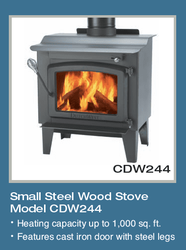Hi Guys, I've been reading here for quite some time, but haven't really posted much. So here's the deal. I am renting a small stone house. 2 floors, but only about 900 sq ft total. Below is the stove that is in the house. It isn't in the greatest of shape, but it put out decent heat for the first few months we were here. So here are a few questions for the experts.
Anyone have an idea what brand/model this is? There aren't any tags or markings anywhere I can find. Looking at the baffle at the top can I assume this is an EPA stove?
I would often have issues with smoke coming back into the house, even after it was up to temp. I did have the chimney swept, it was better for a few weeks, but starts to slip back. The wood I am using is well seasoned, at the time it had about 14 months. Any thing I can look at/clean out?
What other maintenance should I look into for this stove before the cold weather comes?
The chimney is an internal brick, with a SS liner. The internal pipe is single wall.





Anyone have an idea what brand/model this is? There aren't any tags or markings anywhere I can find. Looking at the baffle at the top can I assume this is an EPA stove?
I would often have issues with smoke coming back into the house, even after it was up to temp. I did have the chimney swept, it was better for a few weeks, but starts to slip back. The wood I am using is well seasoned, at the time it had about 14 months. Any thing I can look at/clean out?
What other maintenance should I look into for this stove before the cold weather comes?
The chimney is an internal brick, with a SS liner. The internal pipe is single wall.


